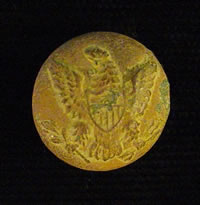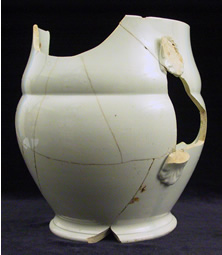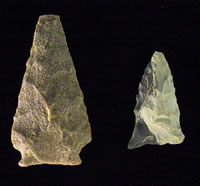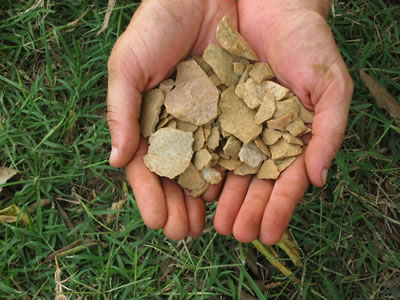October 7, 2002
The City Point archaeological project has been proceeding on three fronts over the last month.
 On September 21 we offered a public open house in conjunction with the “Hooray for Hopwell” event. Our exhibit was put up on the Prince Henry Avenue lot to showcase the results of recent work there. Storyboard panels were displayed describing the process and outcome of the work, with emphasis put on the exciting information in Feature 8, the Civil War pit. A selection of artifacts was provided as well. Turnout was light but those who did stop by were impressed and interested. It was also nice to see new neighborhood friends after some time away from the site.
On September 21 we offered a public open house in conjunction with the “Hooray for Hopwell” event. Our exhibit was put up on the Prince Henry Avenue lot to showcase the results of recent work there. Storyboard panels were displayed describing the process and outcome of the work, with emphasis put on the exciting information in Feature 8, the Civil War pit. A selection of artifacts was provided as well. Turnout was light but those who did stop by were impressed and interested. It was also nice to see new neighborhood friends after some time away from the site.
Throughout the project laboratory work has been quietly underway at William & Mary. The thousands of artifacts recovered already must be carefully washed and catalogued before serious study gets underway. Often it is only after the finds are cleaned that we can understand what they are. The first major product is a complete inventory of all the material excavated on the Prince Henry property. This catalog provides a basis for determining when people were occupying the site and what they were doing there at different times. Each item is coded according to several “attributes”including location of discovery, type of item, method of manufacture, and material it is made from, among others. Some of the more exciting chores in the lab involve mending artifacts that are recovered in pieces, and “conserving” items that are very fragile and suffering from deterioration.  From the large Civil War feature, for example, we were able to reconstruct a large ceramic pitcher found in many pieces. Soon we will begin cleaning the hundreds of iron artifacts covered with corrosion. Details on buttons will be revealed through this process, along with features of metal plates and tools. An impressive quantity of animal bone was recovered from the pit feature, too, and it was just submitted to a specialist who will determine which animals are represented and how the Union army went about feeding its masses of soldiers. Typically, archaeological lab work takes twice as long to complete as the fieldwork – if not more. But it is these specialized studies that produce the most valuable information. Over the last two weeks our crews have returned to City Point to explore two additional lots owned by the City of Hopewell. Survey work has already been completed at property along Pierce Street and it is nearing completion at the fort park between Appomattox and Broadway. Just as it did at Prince Henry Avenue, these systematic survey results provide a good sense of what kind of archaeological potential the city properties have. With this information we can work with the City to determine what further work might be useful.
From the large Civil War feature, for example, we were able to reconstruct a large ceramic pitcher found in many pieces. Soon we will begin cleaning the hundreds of iron artifacts covered with corrosion. Details on buttons will be revealed through this process, along with features of metal plates and tools. An impressive quantity of animal bone was recovered from the pit feature, too, and it was just submitted to a specialist who will determine which animals are represented and how the Union army went about feeding its masses of soldiers. Typically, archaeological lab work takes twice as long to complete as the fieldwork – if not more. But it is these specialized studies that produce the most valuable information. Over the last two weeks our crews have returned to City Point to explore two additional lots owned by the City of Hopewell. Survey work has already been completed at property along Pierce Street and it is nearing completion at the fort park between Appomattox and Broadway. Just as it did at Prince Henry Avenue, these systematic survey results provide a good sense of what kind of archaeological potential the city properties have. With this information we can work with the City to determine what further work might be useful.
 Results at both Pierce Street and the fort park signal periods of intensive use during prehistoric time and during the Civil War. Prehistoric Native American Indian artifacts of stone and pottery are the most common items found in both places. At Pierce Street pieces of pottery and stone tools tell us that it was a favored place throughout the last 10,000 years or so. As at Prince Henry Avenue, some of the pottery at Pierce Street dates from the time of first contact between the English colonists and local Appomatock Indians. The prehistoric occupation of the fort park appears to have been limited mainly to the period before about 2000 years ago. The Civil War presence is indicated by utilitarian artifacts more so than by military items. Pieces of bottle glass and ceramics from the war period are common, as are scraps of iron and nails. A single military button was found in a shovel test at the fort park.
Results at both Pierce Street and the fort park signal periods of intensive use during prehistoric time and during the Civil War. Prehistoric Native American Indian artifacts of stone and pottery are the most common items found in both places. At Pierce Street pieces of pottery and stone tools tell us that it was a favored place throughout the last 10,000 years or so. As at Prince Henry Avenue, some of the pottery at Pierce Street dates from the time of first contact between the English colonists and local Appomatock Indians. The prehistoric occupation of the fort park appears to have been limited mainly to the period before about 2000 years ago. The Civil War presence is indicated by utilitarian artifacts more so than by military items. Pieces of bottle glass and ceramics from the war period are common, as are scraps of iron and nails. A single military button was found in a shovel test at the fort park.
We expect the survey work at the fort park to be completed early next week. Afterward we hope to examine one more lot before launching into intensive report writing.















